
Today’s top web3 games leverage blockchain technology to allow true ownership of in-game assets. They give players the ability to trade NFTs that represent land, player equipment, collectibles, and much more. By contrast, traditional games leave in-game assets on the platform, limiting usage rights.
No longer limited to collectible NFT pets, web3 gaming now offers something for everyone. Explore metaverse worlds, high-action role-playing games, racing games, or strategy games. In this guide, we round up the most popular web3 games to help you decide which game to check out next.
Let’s see what’s out there for gaming fans.
List of the Top Web3 Games in 2024
Here are our rankings for the best web3 games that use blockchain technology in 2024:
- Alien Worlds – P2E space mission-based web3 game with over 134,000 monthly players.
- Star Atlas – Unreal Engine 5 powers this immersive massive multiplayer online role-playing game.
- Matr1x Fire – This cyberpunk first-person shooter offers three modes of gameplay.
- Farmers World – Build a farm and protect it against invaders in this web3 game.
- Splinterlands – Leading card-based game with over $7.2 million awarded to players already.
- motoDEX – Join 7.4 million players in this fun, fast-paced racing game.
- DeFi Kingdoms – Game strategy meets DeFi in this play-to-earn favorite.
- Pixels – Embark on a farming adventure and earn tokens in this popular web3 game.
- StarryNift – Virtual worlds in the Starryverse let players find NFTs and stake for profit.
- Upland – Become a metaverse real estate mogul with properties from the real world and earn yields of up to 15%.
- The Sandbox – Build and monetize your own games and events alongside celebrities and top brands.
- Illuvium – This card-based strategy game gives players an opportunity to earn ILV tokens.
- Gods Unchained – Earn GODS tokens in this card-based blockchain battle game.
- Axie Infinity – Capture and breed new creatures in this popular P2E blockchain game.
Most Popular Web3 Games Reviewed
Let’s explore each game on our top web3 games list in more detail.
1. Alien Worlds – Expansive Exploration and Mining Game With 134,000 Monthly Users
Alien Worlds centers around mining, with a dash of space exploration and in-game events. Players mine Trillium (TLM), also mining Shards simultaneously, the latter of which can be used to purchase NFTs within the game. Landowners receive a daily dose of TLM, along with a percentage of the TLM mined by others on their virtual land.
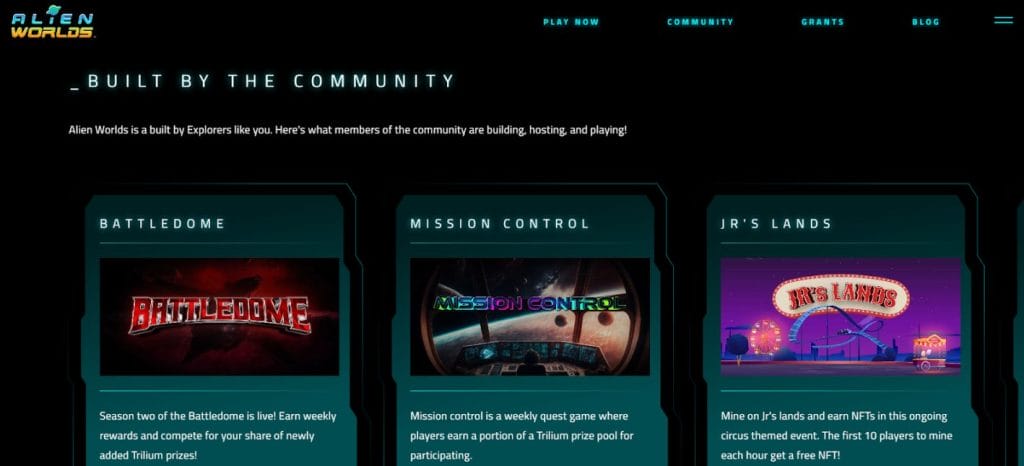
To venture into parts unknown on a mission, players stake Trillium to access ships. Staking rewards can reach up to 10% for longer missions (longer staking periods).
Alien Worlds runs with the help of Syndicates, player-run decentralized autonomous organizations (DAOs). Voting power centers on TLM, making Trillium an essential part of the game. With the max supply capped at 5 billion tokens, TLM could become an attractive asset based on the popularity of the game, which boasts more than 134,000 players monthly.
| Blockchain | Ethereum, WAX, BNB |
| Number of active players (30-day) | 134,000+ |
| Associated cryptocurrency | TLM |
| NFTs supported | Yes |
| Play-to-earn | Yes |
| Supported platforms | Web |
2. Star Atlas – Immersive Gallaxy-Spanning Massive Multiplayer Role-Playing Game
In a gaming sector that often relies on simpler graphics, Star Atlas is turning heads with its immersive metaverse filled with richly rendered scenes, detailed characters, and smooth animation. The Sage Labs team put the Unreal Engine 5 from Epic Games to work in this web3 gaming experience.

At its heart, Star Atlas is a massive multiplayer online role-playing game (MMORPG) with the goal of eventually giving ownership and governance of its metaverse worlds to its community. Two currencies drive the in-game economy: POLIS and ATLAS. Peer-to-peer exchanges support NFT sales, while a built-in decentralized exchange allows seamless swaps.
Choose from one of three factions in the game, each with its own DAC (Decentralised Autonomous Corporation) guilds. Read up on each before making your choice to be sure the DAC you choose matches your goals for the game.
| Blockchain | Solana |
| Number of active players (30-day) | 16,000+ |
| Associated cryptocurrency | POLIS, ATLAS |
| NFTs supported | Yes |
| Play-to-earn | Yes |
| Supported platforms | Windows |
3. Matr1x Fire – Futuristic Cyberpunk First-Person Shooter for Mobile Players
Singapore-based web3 gaming studio Matr1x brings the world’s first FPS (first-person shooter) mobile game to the metaverse. Think Call of Duty, but on your phone or tablet, and with NFTs that allow you to upgrade or trade. The game has already raised $20 million in funding rounds.
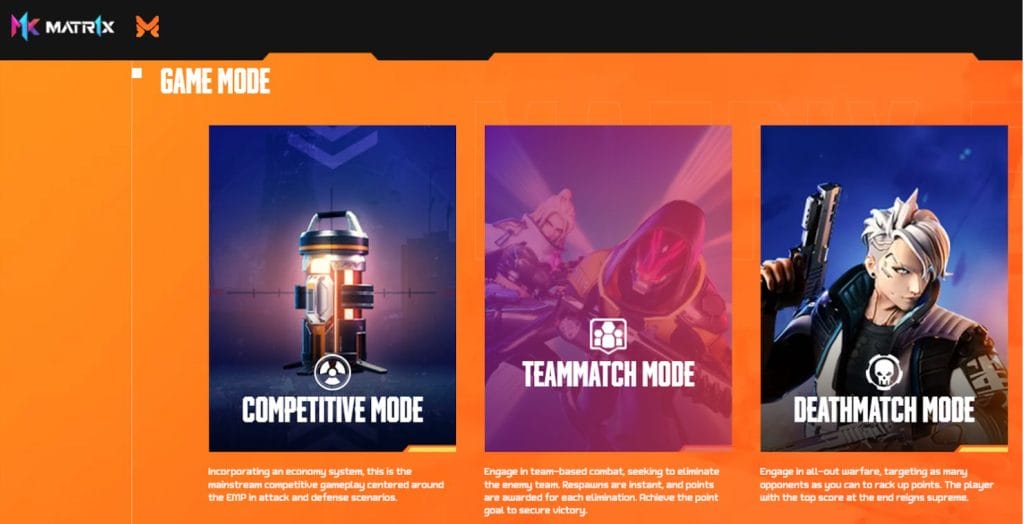
Choose from three gameplay modes, Classic, Battle Royale, and Player vs. Environment, each using NFTs to represent in-game assets, including gear, artwork, and player avatars.
Avatar NFTs range from basic to high-value Legendary and Mythic NFTs. Similar tiers apply to weapons. You Are The Champion (YATC) and MATR1X Kuku NFTs become available to top players as you advance through the game.
FIRE is the in-game currency, allowing players to breed or upgrade avatars and open cases within the game.
| Blockchain | Ethereum, Polygon |
| Number of active players (30-day) | 411,000+ |
| Associated cryptocurrency | FIRE |
| NFTs supported | Yes |
| Play-to-earn | Yes |
| Supported platforms | Android, iOS |
4. Farmers World – Build and Defend Your Farm With 250,000 Monthly Players
While it lacks the visual pizazz of some other top web3 games like Star Altas, Farmers World lets you become a farmer without waking up at four AM to trudge through real-world mud — and without breaking a sweat. Instead, it’s all virtual and on the blockchain.
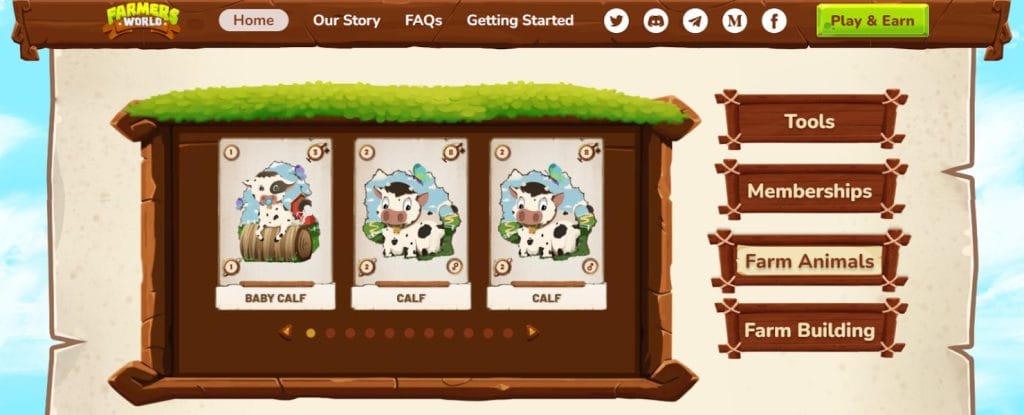
Farmers World makes you the main character, a farmer raising animals alongside a crop. Of course, it’s not quite that simple. You also need to defend your farm against intruders — monsters, in fact. Food (FWF), one of the in-game tokens, serves as energy for defenders. The other in-game tokens are Wood (FWW) and FWG (FWG).
In-game assets are represented by NFTs, some of which come in packs, such as a beginner pack or chicken pack. Your plot of land, barn, and other equipment are also NFTs in the game. If you decide that you’re done farming, you can sell your NFTs on the market, an option not available in traditional games.
Farmers World requires more strategy than you might expect, but it’s a welcoming way to enter the web3 gaming world.
| Blockchain | Wax |
| Number of active players (30-day) | 248,000+ |
| Associated cryptocurrency | FWF, FWW, FWG |
| NFTs supported | Yes |
| Play-to-earn | Yes |
| Supported platforms | Web, (iOS and Android in development) |
5. Splinterlands – Top Card-Based Strategy Game for Web and Mobile Devices
Card-based strategy games are big in web3 gaming, with Splinterlands being one of the biggest web3 games in the segment. If you’ve played Magic the Gathering or Hearthstone, the basic game mechanics should seem familiar. An active marketplace sets this blockchain-based iteration apart, however, allowing players to buy, sell, or trade cards.
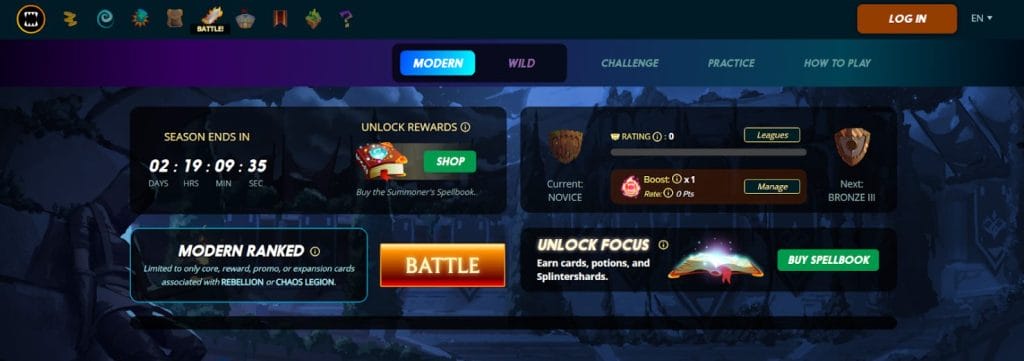
With both web and mobile support (iOS and Android), Splinterlands offers go-anywhere fun, allowing you to sneak in a battle or two on your lunch break.
Cards in Splinterlands come in two groups: summoners and monsters. Each summoner has a specific element, such as Fire, Water, Earth, or four other elements. Similarly, monsters bring their strengths and abilities to battles when summoned.
The game centers on the DEC token as in-game rewards, although as a decentralized game, the SPS token serves as a governance token.
The game is one of the original success stories of Web3 gaming and has an active community of players. Over $7.2 million has been awarded in tournament prizes to date.
| Blockchain | Wax, Hive, BNB |
| Number of active players (30-day) | 72,000+ |
| Associated cryptocurrency | SPS, DEC |
| NFTs supported | Yes |
| Play-to-earn | Yes |
| Supported platforms | Web, iOS, Android |
6. motoDEX – Fast-Paced Racing Fun to Earn Coins and NFTs
If you’re a fan of quick-reflex running and dodging games like Temple Run, you might also enjoy motoDEX, which offers a similar high-action feel in a motorcycle game that doesn’t take itself too seriously.
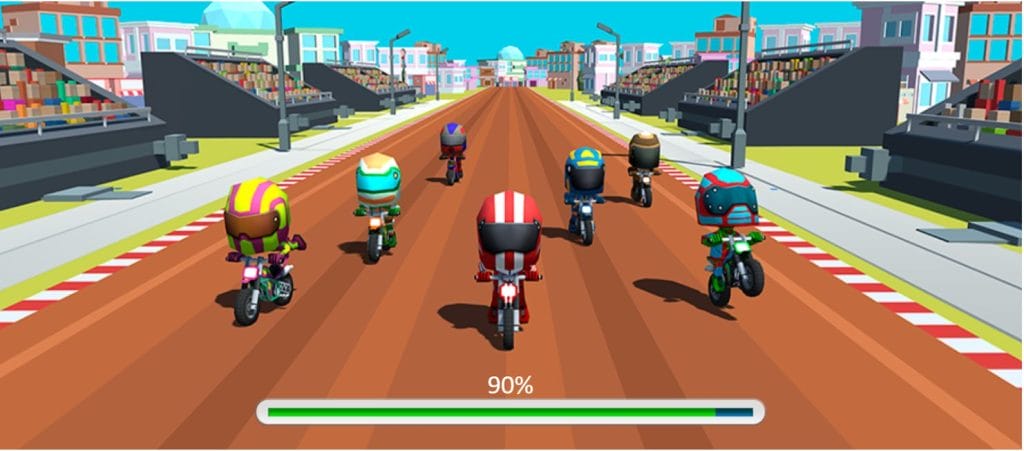
Pilot your bike over bumps and jumps while dodging obstacles like forklifts and the occasional downed rider. motoDEX’s cartoon characters and landscapes make the game an enjoyable romp, although you can also earn money in the game to feed your entrepreneurial tendencies.
Earn coins within the game to purchase NFTs, or channel your inner mogul to own tracks themselves, earning a part of the prize money for races at your tracks.
motoDEX can be as simple or as complex as you want to make the game, but even at its most complex level, the app still delivers easy-to-understand web3 gaming.
| Blockchain | Polygon, Near, Aurora, Nebula, Base, EOS |
| Number of active players (30-day) | 7.3M+ |
| Associated cryptocurrency | – |
| NFTs supported | Yes |
| Play-to-earn | Yes |
| Supported platforms | iOS, Android |
7. DeFi Kingdoms – Trending Role-Playing Strategy Game With DeFi Earnings
Play-to-earn fans who take their craft seriously flock to games like DeFi Kingdoms, where earnings can reach hundreds of dollars daily for skilled players. DeFi Kingdoms combines nostalgic eight-bit art with NFTs, role-playing, and decentralized elements. For example, in-game decentralized exchange pools called The Gardens often offer incredible yields for liquidity providers who provide JEWEL tokens.
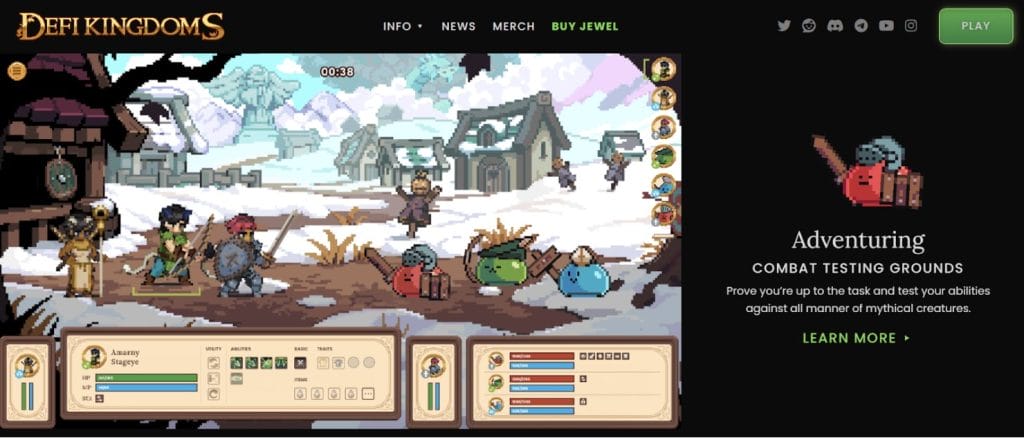
More than 35,000 wallets connect to DeFi Kingdoms monthly, and the Total Value Locked (TVL) is over $24 million, making its in-game economy a vibrant place to transact and trade. However, an effective entry into the game comes at a cost. Expect to invest in a capable hero — or possibly a guild of heroes — to advance in the game faster.
Heroes in the game fall into one of four categories: gardeners, miners, fishers, and foragers. Each type of hero offers its own pathways through the game and distinct types of earning opportunities. Take your unused earnings to the bank to earn a yield in liquidity pools, used to help new players get started with in-game currency (JEWEL). Auto-compound your yields to build a serious stack, having fun adventures along the way.
| Blockchain | Avalanche, Klaytn, DFK |
| Number of active players (30-day) | 35,000+ |
| Associated cryptocurrency | JEWEL |
| NFTs supported | Yes |
| Play-to-earn | Yes |
| Supported platforms | Web |
8. Pixels – Engaging Strategy Gameplay with Play-to-Earn Tokens
With more than 600,000 wallets connecting to Pixels monthly, this blockchain game is worth a closer look. Pixels mixes farming and adventure in a pixelated blockchain universe. But strategy plays a role as well because each decision you make takes you toward a path that determines your opportunities later in the game.
![]()
The Pixels play-to-earn economy centers on the BERRY token, soon to be replaced by the PIXEL token, which players can use to invest in land plots and upgrades. The team at Sky Mavis, the game’s publisher, initially chose a two-token ecosystem, using both PIXEL and BERRY, while taking inspiration from popular web2 games to keep gameplay engaging and support a thriving in-game economy.
Pixels runs on the Ronin blockchain, a well-established gaming chain, after moving from Polygon. Marketplaces like OpenSea offer a vibrant market for NFTs, such as Pixels Farmland, so you can start your digital adventure.
| Blockchain | Ethereum, Ronin |
| Number of active players (30-day) | 607,000+ |
| Associated cryptocurrency | PIXEL, BERRY |
| NFTs supported | Yes |
| Play-to-earn | Yes |
| Supported platforms | Web |
9. StarryNift – Explore and Build Captivating Virtual Worlds While Earning Crypto
Nearly 300,000 crypto wallets connect to StarryNift monthly, making it one of the most active web3 games on the BSC chain. Create 3D worlds in the “Starryverse,” where you can interact with others, earn crypto, and explore.

First experiences with StarryNift parallel Decentraland, credited as being the first decentralized metaverse app. Walk, run, jump, fly, or perform tricks in a seemingly endless virtual reality. Special events and exhibits add to the immersive feel, providing a reason to return. There’s also another reason: you can collect NFTs, which you can then stake to earn rewards.
StarryNift mixes cartoon avatars with richly rendered backgrounds and environments to create captivating worlds. And best of all, you can try it for free without even connecting a wallet.
| Blockchain | BNB |
| Number of active players (30-day) | 297,000+ |
| Associated cryptocurrency | – |
| NFTs supported | Yes |
| Play-to-earn | Yes |
| Supported platforms | Web |
10. Upland – Real Estate Web3 Game Based on Real-World Properties
Metaverse worlds offer a near-perfect match for web3 gaming because of blockchain’s ability to track assets like land, while also providing complete ownership of virtual assets to players. Upland takes a new twist by mixing virtual ownership with landmarks and locations from the real world. Want to buy your neighbor’s house? Go ahead. If it’s available, you can buy the virtual version and put up a taller fence.

New properties in your portfolio can earn up to 15% yields paid in UPX, allowing you to buy yet more properties, compounding your earnings. When it’s time to sell, you can cash out for USD.
As you progress through the game, you become eligible for Uplander status, enabling you to earn Spark to build structure NFTs you can sell on the secondary market. Upland lets you become a virtual real estate mogul with real-world earnings if you play the game well.
| Blockchain | EOS |
| Number of active players (30-day) | 89,000+ |
| Associated cryptocurrency | UPX |
| NFTs supported | Yes |
| Play-to-earn | Yes |
| Supported platforms | iOS, Android |
11. The Sandbox – Monetize Metaverse Worlds and Games You Design
Animoca Brands, a Hong Kong-based gaming publisher, brings us one of the best-known metaverse projects. Leading brands and celebrities have held events in the Sandbox Metaverse, such as Snoop Dogg, Playboy, Atari, Ubisoft, and The Walking Dead.
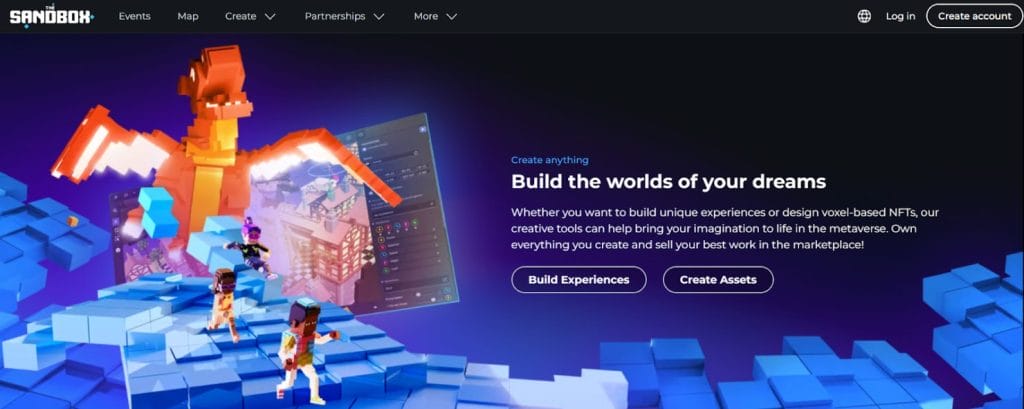
Often compared to Roblox and Minecraft, The Sandbox uses similarly blocky avatars and environments. Also similar to these other games, The Sandbox lets you build your own creations. The difference: you own what you build, including games you build within The Sandbox.
The Sandbox uses the Unity game engine and offers a no-code game maker, which lets you customize virtual worlds with a few clicks. Landowners can monetize the content published on the land they own in the game. Play in single-player mode or join with friends in multiplayer mode.
| Blockchain | Ethereum. Polygon |
| Number of active players (30-day) | 1,700+ |
| Associated cryptocurrency | SAND |
| NFTs supported | Yes |
| Play-to-earn | Yes |
| Supported platforms | Windows |
12. Illuvium – AAA Game Ecosystem Where Players Earn ILV Tokens
Illuvium can be more complex than some web3 games, but this play-to-earn ecosystem is well-suited to strategists and offers several interconnected games. Recently listed on Epic Games, this AAA game has graphics and gameplay that have helped it reach a mainstream gaming audience. The ecosystem consists of four games in total, two of which are in early testing.

Illuviium Beyond, now live, allows players to compete to create Illuvatars, collectible NFTs.
Illuvium Arena (PVP) is in early access. New players in Illuvium PVP get three pre-built decks of cards, with teams comprised of Illuvials you can take into the PVP arena. Upgrade your team with suits, weapons, and augments. As you progress through the game, leveling up your Illuvial, you can fuse to create new Illuvials or advanced forms of Illuvials that are more effective in battle.
The Illuvial ecosystem offers several ways to reward players: capture Illuvials to sell on the marketplace, capture a slot on the leaderboard to earn ILV, or stake ILV to earn ILV or sILV.
| Blockchain | Ethereum |
| Number of active players (30-day) | 200+ |
| Associated cryptocurrency | ILV |
| NFTs supported | Yes |
| Play-to-earn | Yes |
| Supported platforms | Windows, Mac |
13. Gods Unchained – Card-Based Strategy Game For Play-to-Earn Fans
If trading cards are more your speed, Gods Unchained deserves a closer look. With more than 12,000 monthly players, Gods Unchained is already a hit for web3 gamers who prefer a slower pace compared to shoot-em-ups and sometimes-baffing metaverse worlds. The studio behind the game, Immutable, has just launched the mobile version of Gods Unchained.
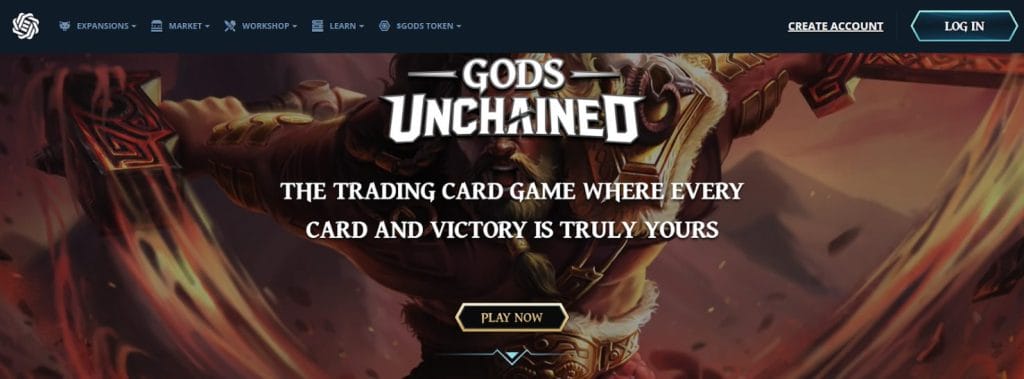
Put your skills to the test with three game modes: solo, ranked, and direct challenge (one-on-one private match). Each match earns EXP, the key to advancing and unlocking new skills.
Earn GODS tokens by completing matches. If you’re not ready to cash out, you can stake your GODS tokens to earn more tokens. Major crypto exchanges offer GODS, so you also have the option to buy tokens and jumpstart your staking earnings.
| Blockchain | Ethereum, Immutable X |
| Number of active players (30-day) | 12,000+ |
| Associated cryptocurrency | GODS |
| NFTs supported | Yes |
| Play-to-earn | Yes |
| Supported platforms | Windows, Mac, Mobile |
14. Axie Infinity – Popular NFT-Based Game With 70,000 Monthly Players
Replace Pokemon with Axies (and put it on the blockchain), and you get the drift of Axie Infinity, the hit game from Sky Mavis. This well-loved game has been with us since 2018. Although the Axie Infinity game fell victim to a major hack in 2022, it still remains one of the most popular web3 games, with more than 67,000 monthly players.
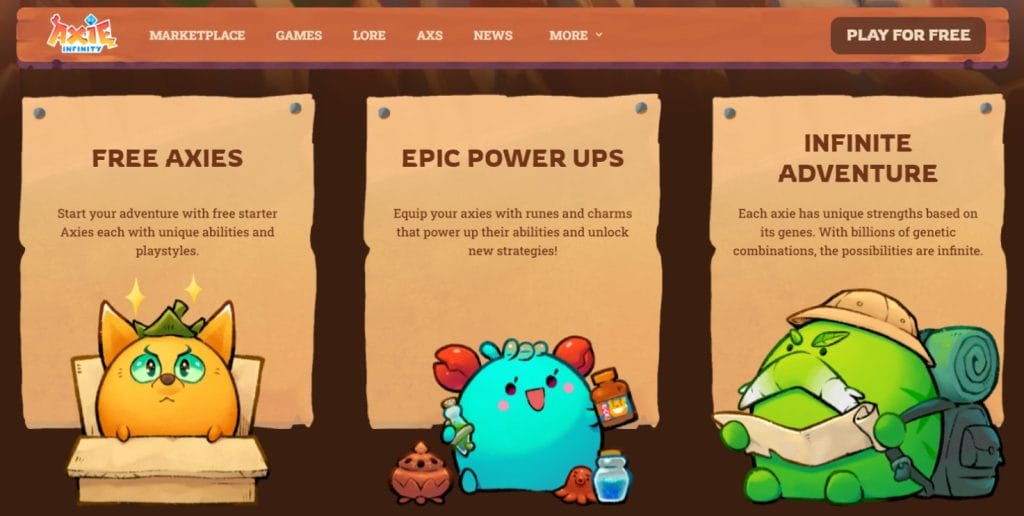
Axie Infinity revolves around Axies, creatures you catch and train, and much like Pokemon, Axies fight other Axies. However, there’s a twist. Axies can breed, making new types of Axies, each represented as an NFT.
If there’s a downside, you have to buy Axies to get started. However, the initial investment can turn a profit as you make your way through the game, earning AXS tokens and unique Axies that you can trade.
| Blockchain | Ethereum, Ronin |
| Number of active players (30-day) | 67,000+ |
| Associated cryptocurrency | GODS |
| NFTs supported | Yes |
| Play-to-earn | Yes |
| Supported platforms | Windows, Mac, iOS, Android |
What Are Web3 Games?
Web3 gaming refers to blockchain-based games in which players own assets in the game, which can then be sold, traded, or otherwise monetized. These assets are then secured by the blockchain used by the game, ensuring the permanence of transactions.
By comparison, traditional games are often a walled garden in which in-game assets remain trapped. If you spend $100 on a custom pink jumpsuit for your avatar in a traditional game, the proceeds go to the gaming company — and if you stop playing, the pink jumpsuit stays there. Web3 enables ownership. In short, you can sell your custom pink jumpsuit.
Web3 gaming also brings the ability to play to earn. Many play-to-earn games allow you to earn game-specific tokens that you can use for upgrades or, in some cases, sell for real-world currencies.
Instead of usernames and passwords, you use a crypto wallet to connect to the game. This offers a way to secure your in-game assets but also performs an equally important function: your wallet address becomes your pseudonymous identity within the game.
Web3 Games vs Traditional Games
Web3 gaming can look similar to traditional games. However, under the hood, web3 gaming studios bring some important distinctions to their games compared to traditional games.
Ownership of In-Game Assets and In-Game Earnings
NFTs (non-fungible tokens) give web3 gamers true ownership of assets. These assets can be transferred to another wallet, traded, or sold. Web3 offers a way to recapture the value of your time or financial investment in the game. In many cases, players can even earn in-game currency or NFTs by playing the game.
By contrast, traditional games typically don’t offer similar portability of assets.
Decentralization vs Centralization
Many web3 games are decentralized, meaning the game is governed by the community, which can vote on proposed changes. Additionally, in-game transactions are governed by smart contracts, which are computer programs that run on the blockchain network. Lastly, transactions themselves are stored on the blockchain, making them immutable (unchangeable), and then distributed to multiple nodes on the blockchain, so there is no centralized server.
By comparison, traditional games use a centralized hub. The game provider itself manages the database, game features, and in-game transactions.
Game ID
Although some web3 games do require registration, your primary method of access is to connect via a crypto wallet. The wallet address you use becomes your pseudonymous identity within the game. You may be able to assign a username as well, with the username tied to the wallet address rather than your real-world identity. This allows a certain degree of privacy in your online adventures.
Traditional games usually require registration, meaning the game company knows who you are.
Equal Access
By using wallet addresses rather than registered users, web3 gaming offers fair access to all. Users interact with smart contracts on the blockchain platform, eliminating the barriers to entry based on real-world identity or location.
By contrast, traditional games may only be available in certain regions, and game companies can ban or restrict users. Some centralized web3 gaming companies can ban users, but this is quite uncommon in the web3 space.
Different Types of Web3 Games
While NFT-based games gave web3 gaming its start, we’ll likely see the types of games continue to evolve. Some will still parallel those found in traditional gaming, albeit with a blockchain-based twist. Many web3 gaming platforms combine two or more of the categories discussed below.
NFT-Based Collectible Games
Axie Infinity was one of the first NFT-based games and remains popular to this day. Players can catch and breed Axies, which are represented by unique tokens on the blockchain. As NFTs, Axies can be bought and sold, giving players true ownership of game assets.
Play-to-Earn Games
The Pixels web3 game provides an excellent example of play-to-earn games. The Pixels play-to-earn economy lets players earn in-game tokens as they progress through the game. Players can then use in-game tokens to invest in upgrades or land plots. Players can sell their PIXEL tokens on outside markets or swap for other cryptocurrencies on decentralized exchanges.
Decentralized Virtual Worlds
Metaverse applications helped web3 games gain a foothold, with land, avatars, and other in-game assets often represented by NFTs. Metaverse apps like Decentraland helped pave the way for web3 gaming awareness by giving players the ability to build their own worlds. These open games often leverage decentralized voting to govern the platform. In short, the community owns the voting rights and may even own the platform itself.
Sport and Racing Games
KittyKart combines a first-person shooter with racing excitement. As a web3 game, KittyKart allows users to earn digital assets, including customizable Karts, all of which are owned by the players themselves, fostering an in-game economy in web3 style.
MMORPGs
EmberSword provides an example of a massively multiplayer online role-playing game (MMORPG). Players interact within a virtual world. The game runs on the Immutable X blockchain, giving players full ownership of in-game assets. Web3 MMORPGs follow in the footsteps of popular games like World of Warcraft but use a decentralized blockchain and pseudonymous identities to secure transactions and offer additional privacy.
How We Ranked The Best Web3 Games
Web3 gaming can entail an investment of time, money, or possibly both. It’s important to evaluate key blockchain game metrics before you invest time or money. We considered several factors when ranking the top Web3 games.
Number of Active Players
We evaluated the number of active players by measuring the number of active wallets over a 30-day period. The number of active players should be weighed in context, however, noting whether changes in active users may be related to new features, deprecated features, or even in-game currency changes, as is the case with Pixels switching to PIXEL tokens rather than BERRY tokens.
Some new P2E games will experience a spike in users when they are first launched, so it’s important to look at how this number sustains over time.
Gameplay Experience
We also considered gameplay experience — after all, a web3 game should be fun first! We also weighed this in context compared to similar games of the same genre. Factors we considered included ease of play and how accessible it is to players.
In-Game Economy
A vibrant in-game economy helps ensure staying power for web3 games. Because of the time or monetary investment involved with some blockchain games, we considered how specific games compared to other games within the same category. We looked at the internal web3 gaming crypto used and how players can use tokens within the game.
Play-to-Earn Mechanics
Earning opportunities within each game vary, with some being much more difficult than others. Part of this difference may be attributed to changes in the number of players. For example, DeFi Kingdoms utilizes liquidity pools as a way for players to earn in the game. As the number of players using this game feature ebbs and flows, earning opportunities may also vary.
Conclusion
Web3 gaming brings several benefits compared to traditional games, including decentralization, privacy-focused features, equal access, and ownership of in-game assets. However, web3 games also come with a learning curve. Players need to have a basic understanding of crypto wallets and how to convert in-game assets into spendable real-world assets.
Overall, the growing prevalence of blockchain-based games benefits the players themselves by offering ownership of assets and often the management of the platform itself through governance tokens. Web3 gaming encapsulates the crypto ethos of financial sovereignty and permissionless transactions, giving gaming control to players. Currently, the top Web 3 game is Alien Worlds which is a community driven metaverse in which explorers can build and play together.
FAQs
What is Web3 gaming?
Web3 gaming refers to games that utilize blockchain technology to secure transactions and allow players to fully own in-game assets, such as avatars, equipment, land, and more.
Can you make money playing Web3 games?
Many web3 games allow users to earn cryptocurrency tokens for completing tasks, accomplishing missions, or achieving goals like leaderboard positions. In some cases, players can also find or capture NFTs that may have value inside or outside the game.
What is the potential of Web3 gaming?
The potential for web3 gaming could be bright, offering in-game economies and assets that can be sold to raise revenue in the offline world or used elsewhere in DeFi applications. Already, web3 gaming offers financial opportunities in both the developed world and developing countries. Web3’s unique approach to in-game asset ownership could continue to attract interest in the space and create more opportunities for wealth building.
What is the most popular Web3 game?
MetalCore, a still-in-alpha open-world role-playing game, is one of the most discussed web3 games. However, several popular web3 games like Upland and Axie Infinity may see more monthly active users.
What games use Web3?
Metaverse worlds, such as Star Atlas and StarryNift, use web3, as well as simpler games like motoDEX and Farmers World.
References
This news is republished from another source. You can check the original article here


